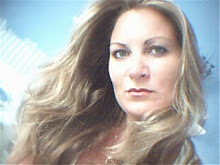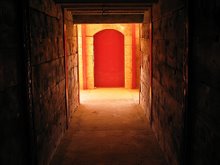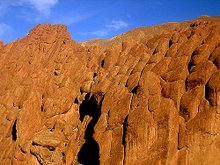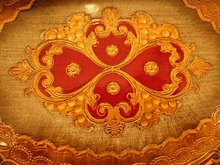 SEVILLE, SPAIN -- April 24, 2006
SEVILLE, SPAIN -- April 24, 2006Ah, Seville. City of flamenco and bullfights, the world's third largest cathedral, and some very elegant architecture... all encompassed by a city sprawling over the southeast corner of the country. Seville is big-city, make no mistake about it. I had a bit of a difficult time adjusting after enjoying the rustic spendor and natural panoramas within a few minutes' walk in Ronda. But Seville grows on you. That Spanish guitar gets in your blood, and you start craving the taste of those tapas (small appetizer-like dishes sold in dozens of varieties at nearly every bar and cafe in town).
I arrived at the brand-new hostel Oasis Backpackers (only 5 weeks since its grand opening -- for those heading to Seville, check them out -- they were incredible!). While getting there was a bit of a hassle, as soon as I arrived, this hostel began feeling like home. John, a traveler from the States whom I met in Granada, had arrived the day before me, and had been waiting for my arrival. We set out into the city to the bullring, where we bought tickets to the bullfight taking place later that evening. I didn't know quite what to expect from a bullfight, but I figured at the very least I could chalk it up to one hell of a Spanish cultural experience.
 Next we wandered along the Rio Guadalquivir and through the sprawling city until we found the Catedral. Seville's Catedral is the third largest in the world, outsized only by St. Paul's Cathedral in London, and St. Peter's Basilica in Rome. The dimensions from the outside were surreal. It was actually built on top of the mosque which dominated Seville back during the reign of the Moors, and the adjoining tower, La Giralda, which served as the mosque's minaret, still stands and provides spectacular views from the top floor.
Next we wandered along the Rio Guadalquivir and through the sprawling city until we found the Catedral. Seville's Catedral is the third largest in the world, outsized only by St. Paul's Cathedral in London, and St. Peter's Basilica in Rome. The dimensions from the outside were surreal. It was actually built on top of the mosque which dominated Seville back during the reign of the Moors, and the adjoining tower, La Giralda, which served as the mosque's minaret, still stands and provides spectacular views from the top floor.Walking through its interior was an interesting experience. A small treasury room held antique metalwork (an intricate crucifix) and paintings depicting religious events (the beheading of John the Baptist). The cathedral itself was dark, despite the large stained-glass windows which decorated its top quarter. I couldn't help but begin to feel lost inside this great cathedral, staring up at a ceiling so high that the tallest of men would feel dwarfed in comparison. If I remember correctly from my college days, this was an intentional architectural decision, made to reflect the humility of man and his dependence on God. This cathedral houses the remains of Christopher Columbus (although supposedly there is a rumor that the tomb is empty and his remains are actually located somewhere in the middle of the Caribbean).
 After a walk through the beautiful Parque de Maria Luisa, we enjoyed a picnic-style lunch in the shade of some immensely tall trees. Everything in Seville seems to be tall! As luck would have it, a flying pigeon paid both of us a visit. That was a first. We continued on to the Plaza de Espana, a gorgeous plaza with fountains and beautiful red-brick buildings forming a crescent. If you're a Star Wars fan, you'd recognize this spot from a scene in Attack of the Clones. Horse carriages clip-clop along the cobblestone streets, and vendors selling toddler-size flamenco dresses and a hefty sampling of trinkets fan out from the street entrance to the fountains.
After a walk through the beautiful Parque de Maria Luisa, we enjoyed a picnic-style lunch in the shade of some immensely tall trees. Everything in Seville seems to be tall! As luck would have it, a flying pigeon paid both of us a visit. That was a first. We continued on to the Plaza de Espana, a gorgeous plaza with fountains and beautiful red-brick buildings forming a crescent. If you're a Star Wars fan, you'd recognize this spot from a scene in Attack of the Clones. Horse carriages clip-clop along the cobblestone streets, and vendors selling toddler-size flamenco dresses and a hefty sampling of trinkets fan out from the street entrance to the fountains.The day was capped off with a very authentic bullfight at the Plaza de Toros de la Maestranza. The warm yellow and bright red tones of this circular edifice mirrored the excitement stirring in the air as hundreds of onlookers -- most of them Spanish -- began filing through the entrance doors to find their seat, a small patch on a hard bench in full sunlight. The buzz of voices rose and rose until finally, the first of the night's performers entered the ring on horseback. I thought it quite hilarious that throughout the event, whenever the volume of voices rose a little too high, a very audible "shoosh" would emanate from the mouths of nearly every spectator, as if they had their own crowd-and-volume control built right into the ring.
I hesitate to give too much graphic detail of the fight itself. I actually watched six of these bullfights, and realized all too quickly that this "sport" was much more gruesome than I had imagined. If it were truly a match between the bull and the matador, things would be different. But from the moment that strong, proud bull enters the ring, he is doomed. Despite his strength, he is no match for the 6-10 men who begin the drawn-out torture that eventually drains him of all energy. After a short-lived dance of red capes which aggravate the bull, a man with a long sword prances into the ring on a decorated horse, and buries the tip of the sword deep into the back of the bull. Blood flows from this fresh wound, and the bull charges at the horse in defense. Another thrust and twist of the sword leaves the bull disoriented. Then three men approach the horse, with a small dagger/sword in each hand, and plunge the steel points into the gaping hole in the bull's back. It is only after the bull has been subjected to such torment that the matador appears.
No doubt about it, the matador is truly a decorated artist, capable of drawing in the crowd with his fluid, masculine movements. It is almost like a dance between him and the bull. But the matador is in control, eking out any remaining energy the bull is clinging onto, before the bull himself falls over in exhaustion and the final blow of the sword is struck. Yet while I have no plans to attend another bullfight, I am not altogether sorry for the experience. Sorry for the bull, yes. Angered that he is put at such an unfair disadvantage, yes. Puzzled by the Spanish obsessions with this odd sport, absolutely. But I wouldn't take it back. It is now a piece of my mental mosaic of what this country is about.
~Melanie









No comments:
Post a Comment